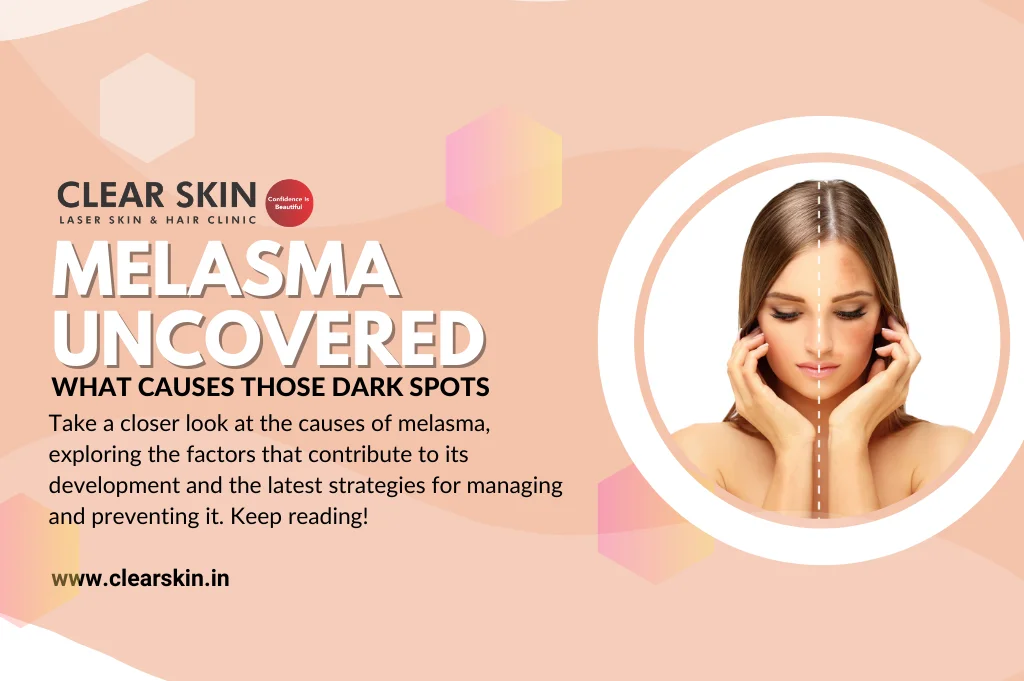
Table Of Contents
What Hormone Imbalances Cause Melasma?
What Causes Hormonal Fluctuations
Hormones and Male Melasma
Are you struggling with dark, discoloured patches on your face that won’t disappear? Have you tried numerous skincare products and treatments with little success? You may be dealing with a common skin condition known as melasma.
Melasma is a frustrating condition that affects many people, particularly women. While the exact cause of melasma is not fully understood, there is a clear connection between hormones and their development. For women, hormonal changes during pregnancy, menopause or with certain medications can trigger melanin production, leading to characteristic dark patches of melasma.
But do hormonal changes cause melasma? Understanding the hormonal connection to melasma is essential in effectively managing and treating this condition. In this article, we will dive into the science behind melasma and hormones, explore the factors contributing to their development, and discuss melasma treatment available in Pune.
What Hormone Imbalances Cause Melasma?
While the exact causes of melasma are not fully understood, it is believed that hormones play a role in its development. Specifically, the hormones estrogen and progesterone are thought to contribute to the development of melasma.

During pregnancy, for example, hormonal changes can trigger melasma in some women. It is so common that the condition is sometimes referred to as “the mask of pregnancy.”
Do you know how high estrogen cause melasma?
High levels or fluctuating levels of estrogen and progesterone can stimulate the melanocytes, the cells in the skin that produce melanin. Melanin is the pigment that gives colour to our skin, and an increase in its production can lead to the development of dark patches on the skin, such as in the case of melasma. Estrogen can also make melanocytes more susceptible to the effects of ultraviolet (UV) rays and inflammation by increasing the number of melanocortin receptors in the skin. These susceptible melanocytes are more prone to produce excess melanin.
When there is an imbalance in the levels of hormones like estrogen and progesterone, it can trigger an overproduction of melanin in certain areas of the skin, leading to melasma.
What Causes Hormonal Fluctuations
Previously we have discussed what hormone imbalance cause melasma. Now let’s explore what causes commonly lead to hormonal fluctuations.
Mensuration
The menstrual cycle is characterised by fluctuations in the levels of estrogen and progesterone, which can affect the production of melanin. During the menstrual cycle, there is a surge in estrogen levels, which can stimulate the melanocytes and lead to the development of melasma.
Melasma may also appear to darken or worsen during certain phases of the menstrual cycle, particularly during the luteal phase, which occurs the week before menstruation. This is because the levels of estrogen and progesterone are high during this phase, which can contribute to the development of melasma.
Pregnancy
Hormonal changes during pregnancy can trigger the development of melasma in some women. The exact cause of melasma during pregnancy is not fully understood, but it is believed to be related to the increased levels of estrogen and progesterone in the body.
During pregnancy, the body produces high levels of estrogen and progesterone to support the growth and development of the fetus. These hormones can stimulate the production of melanin. Increased melanin production can lead to dark patches associated with melasma.
Menopause
Menopause can also lead to melasma due to progesterone imbalance. But how does progesterone cause melasma? During menopause, there is a gradual decline in the levels of estrogen and progesterone in the body. This can lead to hormonal fluctuations, which can contribute to the development of melasma in some women.
Additionally, during menopause, there is an increase in the production of another hormone called luteinising hormone (LH). LH can stimulate the production of melanin in the skin, further contributing to the development of melasma.
Stress

Do you know stress and melasma are also related to each other? When a person experiences stress, the body releases a hormone called cortisol. Cortisol is often called the “stress hormone” because it affects the body’s response to stress. However, prolonged or chronic stress can cause an overproduction of cortisol, disrupting the balance of other hormones in the body.
One of the hormones that can be affected by an imbalance of cortisol is melanocyte-stimulating hormone (MSH). MSH is responsible for stimulating melanin production in the skin, and overproduction of MSH can lead to an increase in melanin production and the development of melasma.
Stress also includes oxidative stress, which is the stress and damage at a cellular level, which can further contribute to the development of melasma. Oxidative stress can damage skin cells and promote inflammation, leading to an increase in melanin production and the development of melasma.
In addition, stress can also disrupt estrogen and progesterone balance, which can further contribute to the development of melasma.
Thyroid
Thyroid hormones are responsible for maintenance of other hormonal levels in our body and thus thyroid disorders, such as hypothyroidism or hyperthyroidism, can lead to hormonal imbalances that affect the production and distribution of melanin in the skin, leading to the development of melasma.
Consulting a dermatologist will guide you to finding melasma treatment in Pune.

Taking Oral Contraceptive Pills
Oral contraceptive pills contain synthetic hormones, similar to estrogen and progesterone, that can affect the production and distribution of melanin in the skin.
If you are taking oral contraceptive pills and experience pigmentation, the expert dermatologist will guide you to get melasma treatment in Pune.
Hormonal Replacement Therapy
Hormonal replacement therapy (HRT) is a treatment that involves taking synthetic hormones to help manage symptoms of menopause, such as hot flashes, mood changes, and vaginal dryness. However, HRT can also cause hormonal imbalances that can lead to the development of melasma.
HRT typically involves taking estrogen and progesterone supplements, which can affect the production and distribution of melanin in the skin. The expert dermatologist will help you to find melasma treatment in Pune due to hormonal replacement therapy.
Hormones and Male Melasma
Melasma, though commonly associated with women due to its connection with hormonal changes, can occur in men too. It will be surprising to know that even in men, hormonal imbalances are often a contributing factor.
In men testosterone and other androgens play a crucial role in regulating the body’s functions, including the production and distribution of melanin in the skin. When the levels of these hormones become imbalanced, it can affect melanin production, leading to the development of melasma.
Hormonal imbalances can be caused by several factors, including thyroid disorders, adrenal gland disorders, and certain medications.

Additionally, UV light remains the single important risk for development of melasma in men too. Especially men who have primary outdoor work with daily sun exposure like construction workers, delivery agents, traffic police etc
Consulting an expert dermatologist can help you to find melasma treatment in Pune.
Conclusion!
The connection between hormones and melasma is complex, and understanding this connection is crucial to effectively managing and treating this skin condition. Hormonal imbalances, caused by factors such as pregnancy, birth control pills, thyroid disorders, and hormonal replacement therapy, can trigger melasma, developing dark patches on the skin.
By working with Clear Skin Clinics, you can take proactive steps to protect your skin, such as wearing sunscreen, avoiding sun exposure during peak hours, and staying hydrated. Our expert dermatologists can recommend medications, lifestyle changes, and cosmetic procedures to manage hormonal imbalances and improve the appearance of melasma.
If you are looking for melasma treatment in Pune, book your appointment with Clear Skin Clinics Today!
For treating your skin condition, feel free to get in touch with one of our best
dermatologists in Pune. You can also call on
+919584584111 to book an appointment at one of our skin clinics near you.




















Leave a Comment
Your email id will not be published.Required fields are marked*